Should You Plant Marigolds in Your Garden? Discover the Bright Benefits
Thinking about adding marigolds to your garden? You’re making a pretty smart choice! These vibrant flowers are not just beautiful but also bring a lot of benefits. Yes, you absolutely should plant marigolds in your garden because they can help repel pests and attract pollinators.
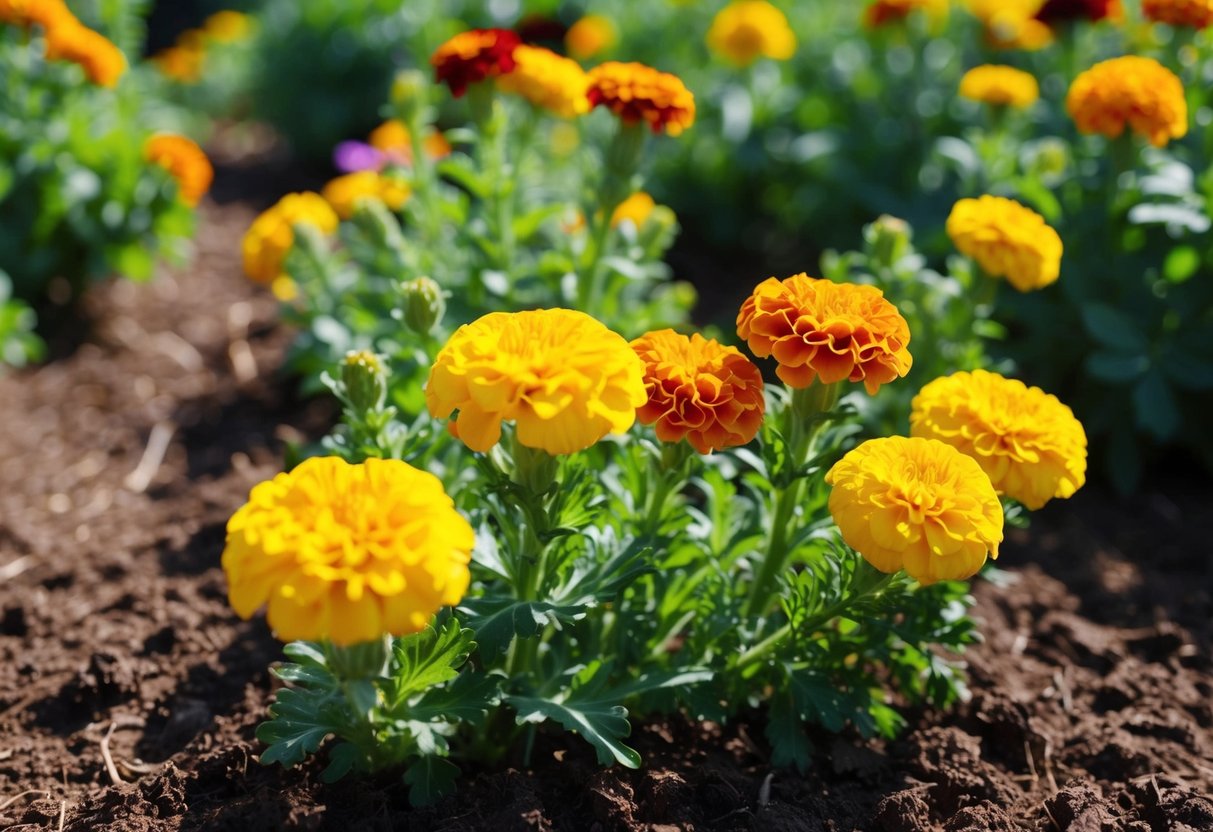
Marigolds are especially great for vegetable gardens. They can keep bugs away and even protect plants like tomatoes. If you’re looking for an easy way to make your garden healthier, marigolds might be just the answer.
Besides their practical benefits, marigolds are simple and hardy plants that can thrive in many climates. Whether you’re an experienced gardener or just starting out, these flowers make a fantastic addition to any garden. So why not give them a try?
Benefits of Planting Marigolds in Your Garden

Marigolds are an excellent addition to any garden and provide several benefits. They are known to attract pollinators like bees and butterflies, which help improve pollination for your other plants.
One key benefit is their ability to deter pests. Marigolds can help keep away aphids and beetles. This natural pest control is both eco-friendly and straightforward. Planting marigolds helps create a healthy balance in your garden.
Marigolds are also effective against nematodes, which are tiny worms that can harm plants. These flowers release chemicals into the soil that repel nematodes, keeping your plants safe from these microscopic pests.
Using marigolds as a companion plant can improve the overall health of your garden. They pair well with many vegetables, making them a valuable addition to your planting strategy.
Another advantage is attracting beneficial insects to your garden. These insects help control harmful pests and reduce the spread of disease among plants.
With their vivid colors and delightful fragrance, marigolds not only make your garden look beautiful but also help maintain its health. If you’re looking to enjoy a flourishing, balanced garden, marigolds are a great choice. Read more about their pest control abilities!
Selecting the Right Marigold Varieties
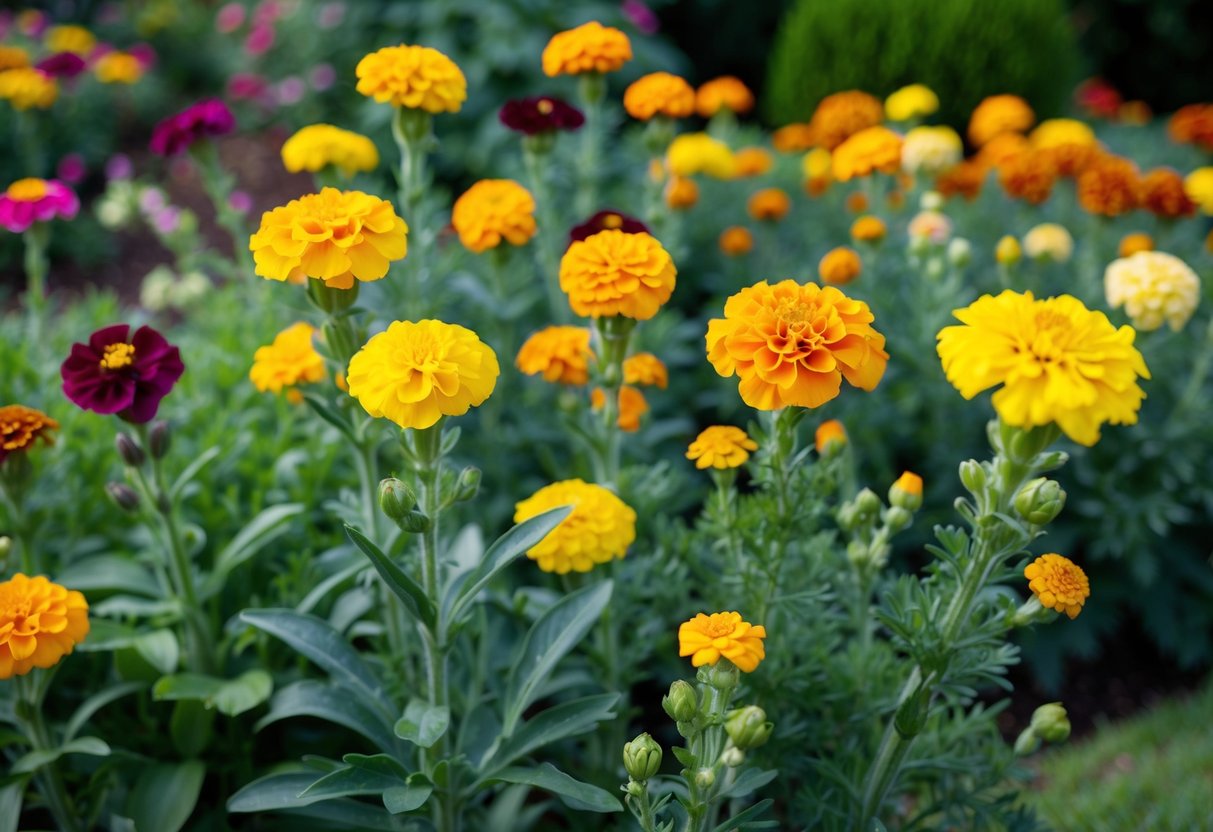
When choosing marigolds for your garden, it’s important to consider their size, color, and growing conditions. Different types offer various advantages and suit specific garden needs.
French Marigolds: Tagetes Patula
French Marigolds are ideal for smaller gardens or borders. They are compact plants, typically growing up to 12 inches tall. Their flowers come in shades of red, orange, and yellow, often with intricate patterns. French Marigolds thrive in full sun and are hardy in a range of soil types. These marigolds are excellent for pest control in vegetable gardens as they help deter nematodes. French Marigolds bloom from spring until frost, offering color and vitality throughout the growing season. Their seeds germinate easily, making them a good choice if you’re looking for an easy-to-grow option.
African Marigolds: Tagetes Erecta
African Marigolds are known for their large blooms and taller growth. They can reach up to 3 feet in height, making them suitable for the back of flower beds or as eye-catching centerpieces. These marigolds prefer full sun and soil that drains well. African Marigolds come in bright yellows and oranges and are often used in cut flower arrangements. Their seeds need warm temperatures to germinate, typically sprouting in 7-14 days. Due to their robust size, they require more space than other varieties. If you’re aiming for showy, vibrant flowers, these are an excellent choice for your garden.
Signet Marigolds: Tagetes Tenuifolia
Signet Marigolds are known for their delicate, lacy foliage and small, edible flowers. They grow best in full sunlight and well-drained soil. Signet Marigolds have a subtle citrus scent, and their blooms are usually bright yellow or orange. They’re perfect for rock gardens or as borders due to their low-growing habit, often reaching just 1 foot tall. Their leaves add texture to garden displays. Beyond their beauty, Signet Marigolds can be used in salads or as garnishes. If you want a marigold that combines beauty with edibility, Signet Marigolds are a great option.
Pot Marigolds: Calendula
Though not a true marigold, Calendula is often grouped with them due to similar growing habits and vibrant colors. Pot Marigolds thrive in full sun and well-drained soil but can tolerate some shade. They produce bright yellow and orange flowers and can reach 1-2 feet in height. Calendula is known for its medicinal properties, often used in ointments and teas. Their seeds should be sown after frost danger passes, and they will readily reseed themselves. If you’re interested in a marigold with herbal benefits, consider adding Calendula to your garden mix. These plants not only bring beauty but also useful health benefits.
Planting and Caring for Marigolds
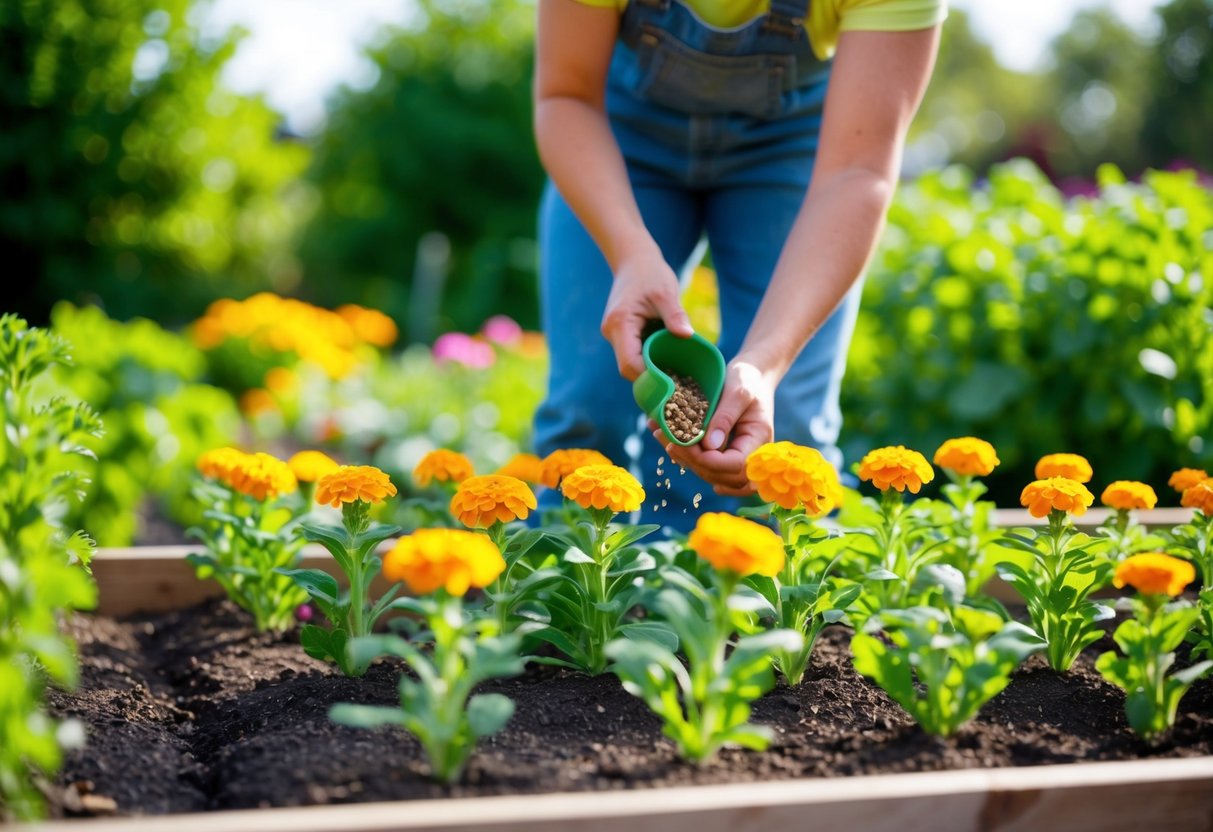
Marigolds are an easy-to-grow flower that brightens up any garden space. They thrive with the right amount of sunlight, water, and basic care, making them perfect for gardeners of all levels.
Optimal Sunlight and Soil Conditions
Marigolds love sunlight. Full sun is ideal, which means they need about 6-8 hours of direct sunlight each day. This exposure helps them bloom beautifully.
For soil, aim for well-draining soil to avoid waterlogging. The soil pH should be around neutral, between 6.0 and 7.0. This ensures healthy growth and vibrant flowers.
If your garden soil is too rich, marigolds might grow more leaves than flowers. So, a leaner soil is preferable. In terms of climate, marigolds do well in warm temperatures and can tolerate hot weather, making them a great choice for summer gardens.
Watering and Maintenance Tips
Watering marigolds is essential but don’t overdo it. They prefer moist soil but can suffer if it’s too soggy. Water them at the base, keeping foliage dry to prevent mildew. Adjust the watering schedule based on the climate; during dry spells, they may need water more frequently.
Maintaining marigolds involves regular deadheading. This means removing spent flowers to encourage new blooms. Deadheading not only boosts flowering but also keeps the plants tidy. Keep an eye out for any pests, as marigolds can attract insects. Maintaining a clean garden bed can help with this.
Fertilizing and Pruning
Since marigolds thrive in lean soil, they require little fertilization. Avoid over-fertilizing as this can lead to fewer flowers. If you do fertilize, a balanced, slow-release fertilizer works best and should be applied sparingly.
Pruning marigolds should be done by pinching back the tops of the plants when they’re young. This encourages bushier growth and more flowers. Regular pruning keeps plants healthy and blooming consistently throughout the season.
By providing attentive care through proper watering, sunlight, and occasional pruning, you’ll enjoy vibrant marigolds that flourish in your garden.
Using Marigolds in Companion Planting
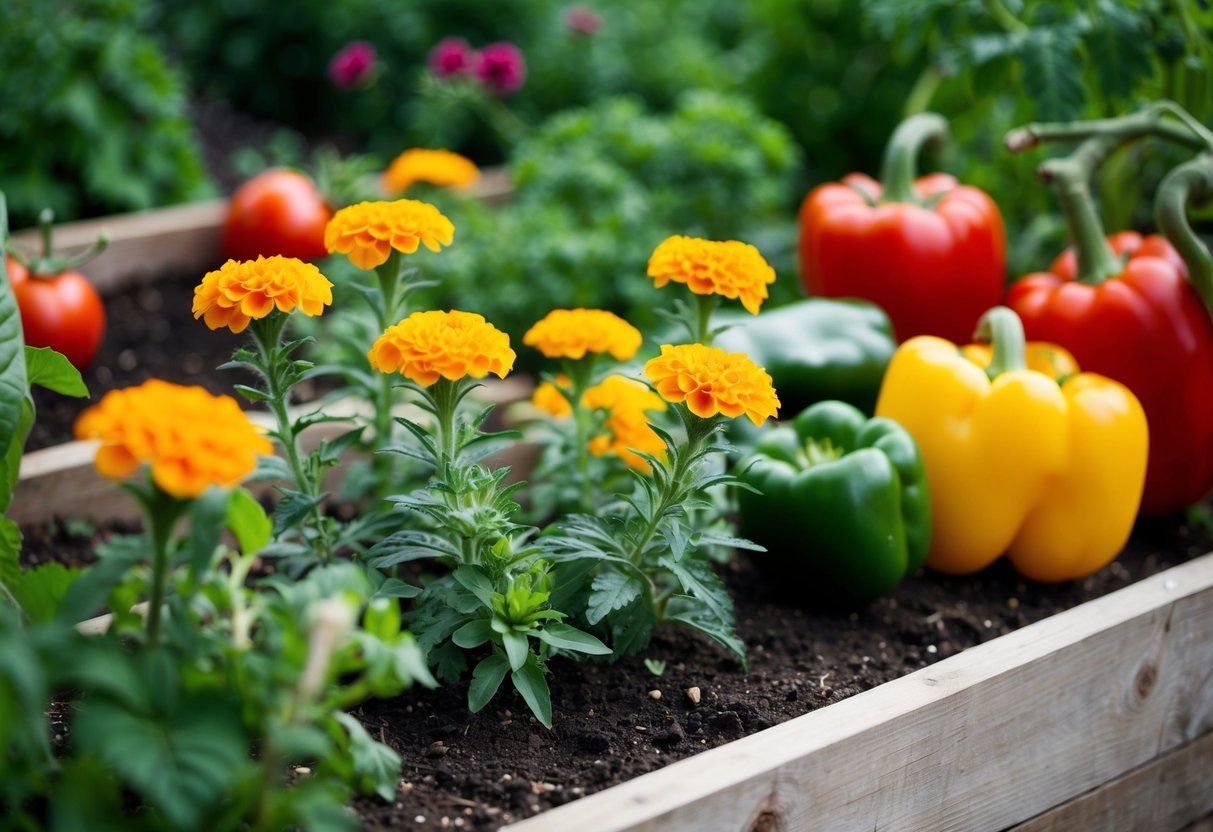
Marigolds are a great choice for companion planting. They help improve growth in vegetables and protect other plants from pests. Below, you’ll learn how marigolds can help your vegetable garden and work well with tomatoes.
Vegetable Garden Harmony
In your vegetable garden, marigolds can be a great ally. They are known for driving away harmful pests like nematodes, which can damage plant roots. This can be particularly useful if you’re growing root vegetables, carrots, or onions.
The vibrant marigold flowers can also attract pollinators like bees and butterflies. These friendly garden helpers boost the productivity of your vegetable plants. Creating a more colorful and bustling garden environment makes your time spent gardening more enjoyable.
Plant marigolds around your vegetable beds in a pattern. By doing so, you create a natural barrier against many unwanted insects. Including different kinds of marigolds, such as French marigolds or African marigolds, can add variety and resilience to your garden.
Companion Plants for Tomatoes
Marigolds make excellent companions for tomatoes. When planted alongside tomatoes, they help reduce nematode levels in the soil. This allows your tomato plants to thrive better.
Tomatoes benefit from marigolds’ ability to repel certain pests, like tomato hornworms. This natural pest control helps reduce the need for chemical pesticides in your garden. Healthy soil and better growth are two main outcomes of this pairing.
Having marigolds ensures your tomato plants receive good pollination support. This results in a more abundant tomato harvest. For an effective garden setup, make sure to plant marigolds close to, but not crowding, your tomato vines. Plant them in the ground or in pots near your tomato plants for easy movement and maintenance.
Harvesting and Propagation
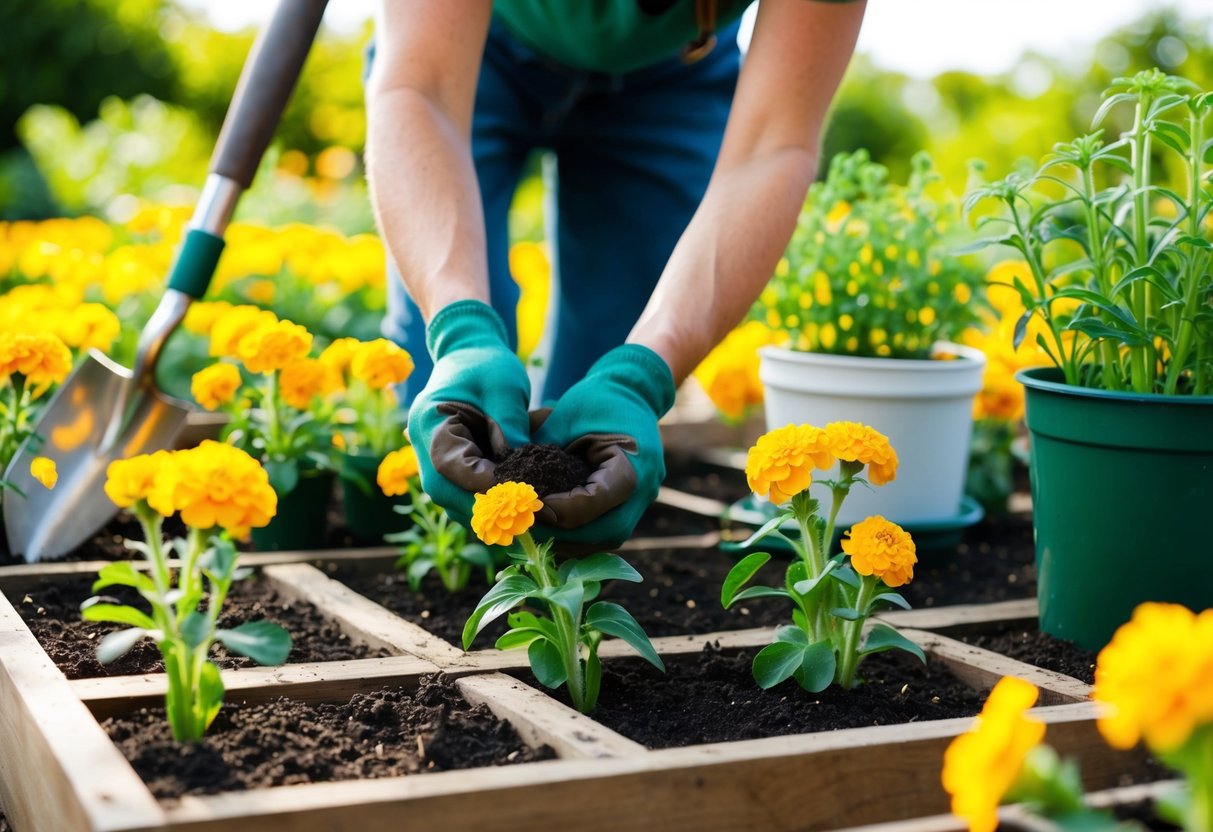
Harvesting and propagating marigolds in your garden can be rewarding. You’ll learn how to collect seeds and ensure successful germination, as well as how to transplant plants to encourage healthy growth.
Collecting Seeds and Germination
When your marigold flowers fade and dry, it’s time to collect seeds. Gently pluck the dried flower heads and place them in a paper bag. Once you’re ready to store them, break open the heads to reveal the thin, black seeds inside. Dry them thoroughly to prevent mold.
To start growing new marigolds, sow the seeds directly into the soil after the frost has passed. Aim to sow them about an inch deep and one inch apart to allow space for germination. Keep the soil slightly moist as the seeds sprout, but be careful not to overwater, which may cause the seeds to rot.
Transplanting Mature Plants
Once your marigold seedlings reach a height of 2 to 3 inches, they are ready for transplanting. Choose a sunny location with well-drained soil for optimum growth. Dig small holes that are slightly larger than the seedling containers. Gently remove the seedlings, keeping as much of the root ball intact as possible.
Place each seedling into its hole and cover roots with soil. Press gently to ensure the plant is secure. Water lightly to help the roots settle. Keep an eye on your transplanted marigolds, ensuring they receive enough sunlight and water as they adapt to their new environment.







